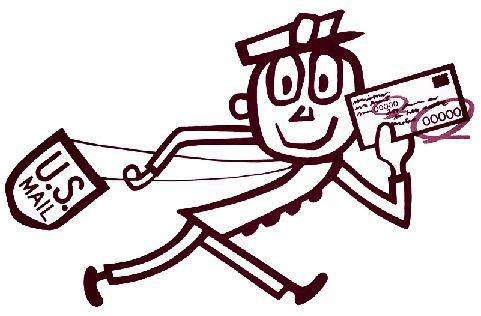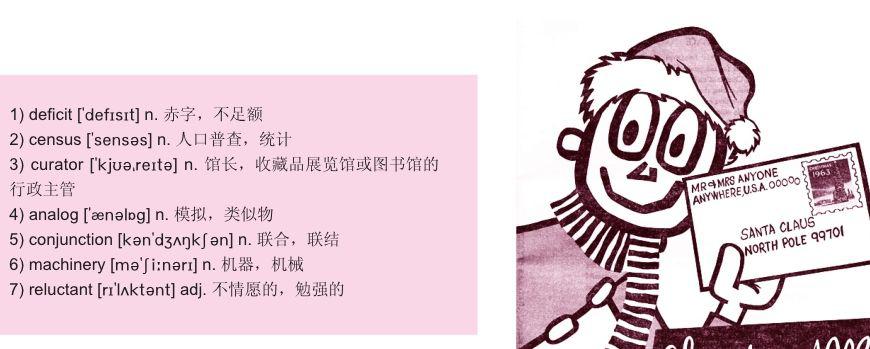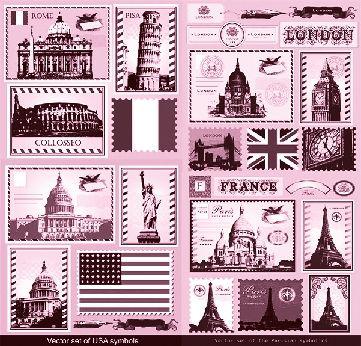“城市的身份证”——邮政编码诞生50周年
2013-10-12ByAudieCornish
By Audie Cornish



1963年7月1日,邮政编码在美国诞生。邮政编码在美国被称为ZIP,是Zone Improvement Plan的缩写,用以应对当时急速增长的邮件投递需求,美国由此成为世界上最早一批拥有邮政编码的国家。
时光如梭,2013年,它迎来了自己50岁的生日。如今,邮政编码已经走遍世界各地,为人们所熟知。那么,这些犹如“城市身份证”的邮政编码背后有着哪些不为人知的故事呢?
Audie Cornish (HOST): The U.S. Postal Service is in the midst of tough times, with a $16 billion 1)deficit and a steep drop in mail. But 50 years ago, that wasnt the case. On this day in 1963, the Postal Service introduced the zone improvement code, better known as the ZIP code. As we hear in this song to promote the new system, the postal service had more mail than ever before.(Soundbite of music)
Unidentified group: (singing) You know you gotta have a ZIP code on the envelope, a ZIP code so you wont get sent back home...
Cornish: Today, the ZIP code is the basis for everything from 2)census counts to voter districts to marketing databases.
Nancy Pope is head 3)curator at the Smithsonians National Postal Museum here in D.C. Welcome to the program, Nancy.
Nancy Pope: Thanks, its nice to be here.
Cornish: So, give us some of the history here. What drove the postal service to come up with the ZIP code?
Pope: Well, they definitely needed some sort of way of creating a digital version of where we are located. Because the old, for lack of a better term, 4)analog
way, just wasnt working anymore. To say someone was in a certain address in New York City, for instance, didnt help when you had twice as much mail in 1960 as you did in 1943, for instance.
Cornish: When you say analog, you mean people are
hand-sorting it. (laughter)
Pope: Yes, exactly.
Cornish: And so, by digital you mean just having some numbers to help out.
Pope: Well, numbers that they could use in 5)conjunction with 6)machinery. A machine could read numbers in the 1950s, you know, it could input data that was numbers. It could not necessarily read an address. So our address, for instance, 2 Massachusetts Avenue Northeast, you try and type that into a machine youre going to be processing at the slowest rate on history. But if you were to type in 2-0-0-0-2, that letter is going to go through a machine much more quickly. Cornish: So just how big a difference did it make for service? Pope: Well, it was really amazing because you had before people who were hand-sorting. And hand-sorting, even if youre really good at it, youre not going to do more than 60 letters a minute. I mean, that would be topping out as the best sorter on record for the postal service. So most of them were sorting in the 20 and 30 letters per minute but when they had a machine and could use the machine to help move things along, they ended up sorting at 1,700 letters per minute, which was quite the difference.
Cornish: Now, the postal service had to come up with this whole like marketing campaign to convince people to use it, right? We have a clip from the “Mr. Zip” campaign.(Soundbite of advertisement)
Unidentified man: This is Mr. Zip. He revolutionized the mail delivery system of the United States with a ZIP code. The heart of the system is a number, a ZIP code number...
Cornish: So whats the deal with Mr. Zip? I mean, did people really need convincing to use a ZIP code and, if so, I mean, what are the reasons they were 7)reluctant to use it?
Pope: They really did need convincing. AT&T; had just been rolling out area codes for people to use. And AT&T; told the post office department youre going to need a lot of help because people hate area codes. They hate having to remember three more numbers. So here you had the post office department about to roll out a campaign to ask people to remember five numbers for every address they would send something to.
And it was also at a time when people were having to use their Social Security numbers more often. And so, here you have people who are feeling like theyre being turned into numbers. Now we may not be able to imagine what it was like because we kind of have completed that being turned into numbers concept. But in the 60s, it was kind of scary for the American public.
And so, Mr. Zip was a very, very friendly, happy young guy who would lead you into this wonderful future. And he would not lead you into the scary one.
Cornish: Nancy, do you have a favorite ZIP code?
Pope: Of course, I do. Everyone does. Mine is 97801.
Cornish: Which is?
Pope: My hometown, Pendleton, Oregon. (laughter)
奥迪·柯妮什(主持人):美国邮政管理局正处于艰难时期,160亿美元的亏损和邮件投递量的急剧下降。但是半个世纪以前,情况却不是那样。1963年的今天(译者注:指1963年7月1日),邮政管理局引进了邮政区域改进编号,也就是我们所说的邮政区域改进计划即邮政编码。正如我们现在听到的这首新制度的宣传歌,当时邮政服务业的投递量多得前所未有。
(音乐片段)
匿名乐队:(唱歌)你知道你该在信封写上邮政编码,邮政编码使你的信不再被退回来
……
柯妮什:如今,邮政编码成为从人口普查、选区登记、市场数据库等方方面面的基础。
南希·波普是位于华盛顿特区的史密森尼国家邮政博物馆馆长。欢迎您的到来,南希。
南希·波普:谢谢,非常高兴来到这里。
柯妮什:那么,在这儿给我们说说(邮政编码的)历史吧。是什么促使邮政服务业想出邮政编码的?
波普:嗯,他们确实需要通过某种方式建立一套用于定位的数字系统。因为旧的模拟方法,怎么说呢,当时已经不再适用了。举个例子,说某人在纽约市的一个特定地点,对于在比1943年多了不只一倍投寄量的1960年来说,根本发挥不了作用。
柯妮什:你说的模拟(机器)操作,是指靠人工进行信件分拣吗?(笑)
波普:是的,没错。
柯妮什:所以,你说的用数字系统指的是利用一些数字来解决。
波普:嗯,通过数字他们可以靠机器分拣。你知道的,20世纪50年代,机器已经能够识读数字,它可以输入数字形式的数据。它未必会识读地址。所以我们的地址,举个例子,马萨诸塞大道东北2号,你试试,将那个地址输入机器,而它将以历史上最慢的速度进行处理。但是如果你输入20002,那些字母那封信会通过机器处理得更快。
柯妮什:那么这使得邮政服务发生了怎样巨大的改变?
波普:嗯,这十分惊人,因为这之前只能靠人工分拣信件。而即使你再擅长,也不能在一分钟之内分拣超过60封信件,我是说,那是有邮政服务业最优秀的分拣员的速度纪录。所以,大多数分拣员每分钟只能分拣二三十封信件,但是当他们拥有并使用机器帮助他们干活时,他们每分钟可以分拣1700封信件,这就是非常大的不同。
柯妮什:现在,邮政服务业想出这一整套类似市场活动的方法来说服人们使用邮政编码,对吗?我们有这个“邮编先生运动”(宣传)的片段。(广告片段)
匿名男声:这是邮政编码先生。他用邮政编码改革了美国的邮件投递系统。这个系统的核心就是数字,一串邮编数字……
柯妮什:那么邮政编码先生是怎么回事呢?我是说,人们真的需要被说服使用邮政编码吗,如果是的话,我想问的是,人们不情愿使用邮政编码的原因是什么?
波普:他们确实需要被说服。美国电话电报公司曾经推行地区编码供人们使用。他们告诉邮局部门作好准备,因为人们讨厌地区编码。他们讨厌必须记住三位以上的数字。因此邮局部门必须推出一个活动劝说人们记住代表他们想要投寄物品信件的每个地址的五位数字。
同时这也是人们必须更常使用自己的社会保障号的时期。因此,人们感觉自己快要变成数字了。现在我们无法想象那究竟是种什么感觉,因为我们已经完成数字概念的转变。但是在60年代,对美国大众来说还是件令人恐惧的事。
所以说,邮编先生是一个非常非常友好和快乐的年轻人,带着你进入这个美好的未来,而不是那个令人恐惧的世界。
柯妮什:南希,你有最喜欢的邮政编码吗?
波普:当然有,每个人都有。我最喜欢的是97801。
柯妮什:是哪儿的?
波普:我的家乡,俄勒冈州彭德尔顿。(笑)
Read More
The code was designed to get mail sorted and delivered faster, and it worked, in part because it allowed for automated sorting. So on the ZIP codes golden anniversary, July 1, here are some facts about those codes and postal delivery in general:
The U.S. Postal Service already had been using two-digit codes for large cities since 1943. It introduced five-digit codes in 1963 for all addresses.
1943年起,美国邮政管理局已经开始在大城市使用两位数字编码。1963年开始在全美所有地址引入五位数字编码。
When the postal service unveiled plans for the nationwide five-digit ZIP code in 1962, it simultaneously[同时] introduced the world to Mr. ZIP, the cartoon character credited with helping win the publics support for the plan.
1962年,当邮政服务业宣布将在全国推行五位数字邮政编码计划时,同时还向世界推出了邮政编码先生,这位卡通人物旨在帮助赢得民众对该计划的支持。
In 1983 the postal service started an expanded system that it called ZIP+4, adding four digits to further specify locations, but it was resisted by many customers.
1983年,邮政服务业开始使用称为“邮政编码+4”的更完善的系统,加上四位数字来进一步精确定位,但是受到许多客户的抵制。
There are about 43,000 ZIP codes in the U.S.
如今全美共有大约43000个邮政编码。
The postal service is considering geocoding, the process of associating precise latitude[纬度] and longitude[经度] coordinates with physical addresses, including ZIP code boundaries, to help form more efficient routes and speed mail and parcel[包裹] delivery.
邮政服务业正考虑使用地理定位,这是使用精确的经纬度来定位物理地址的过程,包括邮政编码分界线地区,以助于构建更有效的路线及更高效的信件和包裹投递服务。
Among the other entities that benefit from ZIP codes are real-estate firms that use them to organize listings, insurance companies that use them to determine premiums[保险金], scientists who use them for research, governments using them to allocate funds, nonprofit organizations that use them in fundraising efforts, and businesses using them to determine where customers are coming from and where to build stores.
在从邮政编码中受益的实体包括使用邮编来编排目录的房地产公司、确定保险费的保险公司、进行研究的科学家、分配基金的政府部门、筹集资金的非营利性组织,以及靠邮政编码来决定顾客出处和商场选址的商人。
The postal service delivers 40% of the worlds mail to 5% of the worlds population.
邮政服务业投递世界上40%的信件给全世界5%的人口。
The postal service processed 160 billion pieces of mail in 2012.
2012年,(美国)邮政服务业处理了1600亿封信件。
The postal service has more than 522,144 career employees.
邮政服务业有522144名雇员。
世界各地邮政编码体系
☆ 中国
我国于1974年开始研制邮政编码,1980年7月1日开始正式在全国宣传推行,后来因为种种原因,推行工作全面停止,直到1986年才重新进行。目前我国采用的邮政编码为“四级六码制”,即每组编码由六位阿拉伯数字组成。四级是指省(自治区、直辖市)、邮区、县(市)邮电局和投递局(区)。六位编码前两位代表省(自治区、直辖市),第三位代表邮区,第四位代表县(市),最后两位数字代表是从该城市哪个邮递区投递的,即投递区的位置。
☆ 中国港澳地区
香港的国际邮政编码为999077,但并未采用。在实际操作中,寄往香港的国际邮件只需要在信封上写上中文及英文都是邮寄到香港的(当然还要附上详细地址)即可,可以不必填写邮政编码。
澳门的邮政编码为999078。
☆ 美国
美国的邮政编码称为ZIP,包括五个数字,随后增加了四个数字,使邮件可以更精确地递送到目的地。在五位数字邮编中,第一位代表美国各州,第二、三位组合代表一个地区或一个大城市,第四、五位组合代表更加具体的区域,譬如某城市的小镇或地区。
☆ 英国
英国的邮政编码称为Postcode,是英文字母和数字混用编码,其格式系统大概是全球最复杂的。
☆ 法国
法国的邮政编码始于1972年,共5个数字,前两位代表省,后三位分别代表城市、地区和邮政分局。
☆ 加拿大
加拿大的邮政编码由3个拉丁字母和3个数字混合组成,书写时前三字和后三字通常以空白分开,其中6个字中,奇数位为英文字母A—Z,偶数位为阿拉伯数字0—9。
☆ 日本
日本的邮政编码系统于1998年2月2日投入使用,共7位数字,前三位与后四位数字之间用字符“—”分隔。
☆ 意大利
意大利的邮政编码为I、IT或者无前缀加上5位数字组成。其中,第一位数字代表邮区,第二位代表省份,第三位表示本地,第四、五位表示投递区域。
☆ 新加坡
新加坡的邮政编码为6位数字组成,前两位是投递区码,后四位代表投递点。
☆ 阿根廷
阿根廷的邮政编码由7个字组成,称为CPA。其中第一个字母为省代码,接下来4个数字代表邮区,后接3个字母表示建筑物区面。
☆ 澳大利亚
澳大利亚的邮政编码为4位数字,因为澳大利亚中部为无人或少人居住的沙漠地区,所以部分邮政编码代表的区域跨越2、3个州。
☆ 瑞典
瑞典自1968年5月12日起使用代表地理位置的5个数字来分类邮件,其中以10—19为首的编号代表斯德哥尔摩。
☆ 西班牙
西班牙的邮政编码由5个数字组成,其中第一、二位表示省份,第三位表示大城镇、主要地区,第四、五位表示投递地区。
